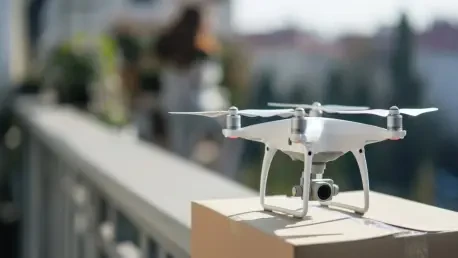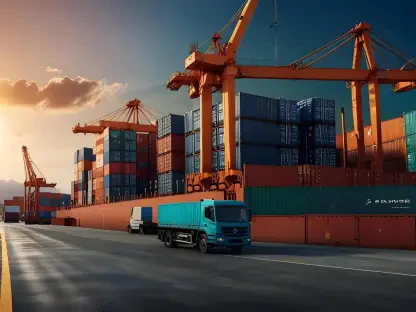Imagine a bustling city where packages arrive at your doorstep within hours of ordering, not through crowded streets or delayed trucks, but via silent, swift drones navigating the skyline with pinpoint accuracy. This scenario is no longer a distant dream but a tangible reality being shaped by autonomous UAV logistics, a technology redefining how goods move in urban and remote landscapes. With the global e-commerce market soaring and last-mile delivery challenges intensifying, unmanned aerial vehicles (UAVs) offer a transformative solution to efficiency and cost barriers. This review dives deep into the core of autonomous UAV logistics, exploring its foundational technologies, real-world impact, emerging trends, and the hurdles it must overcome to cement its place in modern supply chains.
Foundations of Autonomous UAV Logistics
At the heart of autonomous UAV logistics lies a sophisticated blend of hardware and software designed to transport goods without human intervention. Drones, equipped with advanced sensors and navigation systems, form the backbone of this technology, seamlessly integrating into broader logistics networks to ensure timely deliveries. These systems rely on real-time data processing to chart optimal flight paths, avoid obstacles, and adapt to dynamic conditions, marking a significant leap from traditional ground-based methods.
The rise of UAVs aligns with the broader push toward automation, particularly in addressing the inefficiencies of last-mile delivery. As consumer expectations for rapid shipping grow, conventional logistics struggle with traffic congestion and high labor costs, creating a pressing need for innovative alternatives. Autonomous UAVs step into this gap, promising reduced delivery times and operational expenses while reaching areas inaccessible by standard means.
This technology’s importance extends beyond commercial applications, influencing sectors like emergency response and military operations where speed and precision are paramount. By contextualizing UAVs within the automation landscape, it becomes clear that their adoption is not just a trend but a fundamental shift in how global supply chains operate, driven by the demand for agility in an increasingly connected world.
Core Technologies and Innovations in UAV Logistics
Vertical Take-Off and Landing (VTOL) Capabilities
One of the standout features of modern UAV logistics is Vertical Take-Off and Landing (VTOL) technology, which allows drones to operate in tightly constrained urban environments without the need for runways. This capability enables drones to hover, ascend, and descend vertically, offering unparalleled flexibility in densely populated areas where space is at a premium. VTOL-equipped UAVs can launch from rooftops or small pads, making them ideal for city-based delivery hubs.
The performance of VTOL systems in real-world settings has been impressive, with many drones demonstrating stability even in challenging weather conditions. This adaptability expands the operational scope of autonomous logistics, allowing companies to service high-rise buildings or crowded districts efficiently. Such versatility is critical for scaling UAV operations in metropolitan regions, where traditional delivery methods often falter.
Beyond urban applications, VTOL technology enhances mission versatility for military and emergency use, enabling rapid deployment in varied terrains. As manufacturers refine this feature, its integration into larger fleets signals a future where UAV logistics can tackle diverse logistical challenges with ease, pushing the boundaries of what automated delivery can achieve.
Advanced Battery and Endurance Solutions
Battery technology remains a cornerstone of UAV logistics, directly impacting flight duration and payload capacity. Recent innovations in high-density lithium-ion batteries and alternative energy solutions have significantly extended flight times, allowing drones to cover longer distances without frequent recharging. This progress addresses one of the primary limitations of earlier UAV models, which struggled with short operational windows.
The technical advancements in battery efficiency also translate to increased payload capabilities, enabling drones to carry heavier packages over extended ranges. For instance, some cutting-edge systems can now sustain missions of up to an hour while transporting loads that rival small courier vans, making them viable for a broader range of delivery tasks. This shift is pivotal for commercial applications where volume and distance often dictate profitability.
Moreover, ongoing research into sustainable power sources, such as solar-assisted charging, hints at even greater endurance in the near future. These developments not only bolster the practicality of UAV logistics for long-haul routes but also reduce environmental impact, aligning with global sustainability goals. The trajectory of battery innovation continues to be a key determinant in the widespread adoption of this technology.
Autonomous Mesh Fulfillment Networks
A groundbreaking innovation in UAV logistics is the emergence of autonomous mesh fulfillment networks, which coordinate multiple drones through decentralized systems for seamless delivery operations. Implemented in tech-forward regions like Dubai, these networks use cloud-based algorithms to manage drone traffic, optimize routes, and ensure efficient handoffs between units. This approach minimizes downtime and maximizes coverage across wide areas.
Scalability is a major strength of mesh networks, as they can adapt to growing demand by integrating additional drones without overhauling infrastructure. Such flexibility is evident in pilot programs where hundreds of UAVs operate simultaneously, delivering goods with minimal human oversight. The result is a drastic reduction in delivery times and costs, particularly in urban centers with high order volumes.
The contribution of these networks extends to enhancing reliability, as they can dynamically reroute drones in response to unexpected disruptions like weather changes or airspace restrictions. This resilience is crucial for maintaining service consistency, positioning mesh networks as a foundational element in the evolution of autonomous logistics and a blueprint for global implementation.
Emerging Trends in UAV Logistics
The landscape of autonomous UAV logistics is rapidly evolving, driven by technological breakthroughs and shifting market dynamics. Advances in artificial intelligence are refining navigation and decision-making capabilities, enabling drones to handle increasingly complex environments with greater autonomy. This trend is complemented by growing investments in drone infrastructure, such as dedicated air corridors and charging stations, which are essential for mainstream integration.
Consumer demand for instant delivery services continues to fuel innovation, pushing companies to develop faster, more efficient UAV systems. Urban areas are witnessing the rise of smart hubs—centralized facilities for drone takeoffs and landings—that streamline operations and reduce congestion on the ground. These hubs represent a strategic pivot toward creating ecosystems tailored for aerial logistics.
Additionally, the dual-use potential of UAVs for both commercial and military purposes is gaining traction, with defense sectors allocating substantial budgets to procure advanced drone fleets. This convergence of interests is accelerating R&D efforts, as technologies developed for one domain often spill over into the other, fostering a cycle of continuous improvement and broader application.
Real-World Applications and Use Cases
Autonomous UAV logistics is already making a tangible impact across diverse sectors, with e-commerce leading the charge in last-mile delivery solutions. Major platforms in the Middle East, such as Noon, have partnered with UAV providers to expedite shipments, slashing delivery windows in regions with booming online retail markets. These implementations showcase how drones can transform customer experiences by ensuring rapid, reliable service.
In military contexts, significant defense budgets, like those of the U.S. Department of Defense, are driving the adoption of UAVs for tactical logistics, including supply drops in remote or hostile zones. These applications highlight the technology’s ability to operate under high-stakes conditions, delivering critical resources where traditional methods are impractical or too risky.
Unique use cases, such as urban delivery hubs and cross-border logistics, further illustrate the versatility of autonomous UAVs. From ferrying medical supplies between hospitals to enabling trade across national boundaries, these deployments underscore the technology’s potential to address niche challenges, paving the way for broader systemic integration in global supply chains.
Challenges and Limitations in UAV Logistics
Despite its promise, autonomous UAV logistics faces significant technical hurdles, particularly in navigating complex environments like urban canyons or areas with dense electromagnetic interference. Ensuring drones can safely operate amidst skyscrapers, power lines, and unpredictable pedestrian traffic requires ongoing advancements in sensor technology and machine learning algorithms, which remain a work in progress.
Regulatory challenges also pose a formidable barrier, as airspace management struggles to keep pace with the proliferation of UAVs. Governments worldwide are grappling with establishing standardized rules for drone operations, balancing safety concerns with the need to foster innovation. Until cohesive frameworks emerge, widespread deployment will likely encounter delays and restrictions.
Market barriers, including high initial costs for fleet development and consumer skepticism about drone reliability, further complicate adoption. Addressing these issues demands substantial R&D investments and public education campaigns to build trust. While progress is being made through industry advocacy and pilot programs, overcoming these obstacles is essential for unlocking the full potential of this technology.
Future Outlook for Autonomous UAV Logistics
Looking ahead, the trajectory of autonomous UAV logistics points toward transformative advancements that could reshape global supply chains. Potential breakthroughs in AI-driven navigation promise to enhance drones’ ability to operate autonomously in even the most challenging settings, reducing reliance on human oversight. Such progress could redefine urban planning by integrating aerial delivery as a core component of city infrastructure.
Battery technology is another area poised for significant leaps, with next-generation solutions expected to double flight ranges within the next few years from 2025 to 2027. This would enable UAVs to tackle intercity routes, expanding their utility beyond localized deliveries. Coupled with scalable autonomous networks, these innovations could create a seamless web of aerial logistics spanning continents.
The long-term impact on defense strategies is equally profound, as militaries increasingly rely on UAVs for both combat and logistical support. Companies at the forefront of this space, such as Dynamic Aerospace Systems, are likely to play a pivotal role in shaping these developments, either by driving innovation or adapting to emerging standards, positioning them as key players in a rapidly maturing industry.
Final Reflections on Autonomous UAV Logistics
Reflecting on the journey of autonomous UAV logistics, it becomes evident that this technology has carved a remarkable path in redefining delivery systems across commercial and military domains. Its core innovations, from VTOL capabilities to advanced battery solutions, have tackled longstanding inefficiencies with impressive results. Real-world applications demonstrate its versatility, while emerging trends hint at an even broader scope of influence.
Looking back, the challenges of navigation, regulation, and cost stand as significant hurdles that have tempered the pace of adoption. Yet, the strides made in addressing these issues through dedicated research and strategic partnerships offer a glimpse of resilience and potential. The balance of risks and opportunities shapes a narrative of cautious optimism for stakeholders invested in this space.
Moving forward, the focus should shift toward actionable solutions, such as advocating for unified global regulations to streamline airspace integration and investing in public-private collaborations to drive down costs. Exploring hybrid models that combine UAVs with ground logistics could further enhance efficiency, while continuous monitoring of technological breakthroughs will be crucial. These steps, if prioritized, could ensure that autonomous UAV logistics not only meets but exceeds the expectations set during its formative years, cementing its role as a cornerstone of future supply chains.









